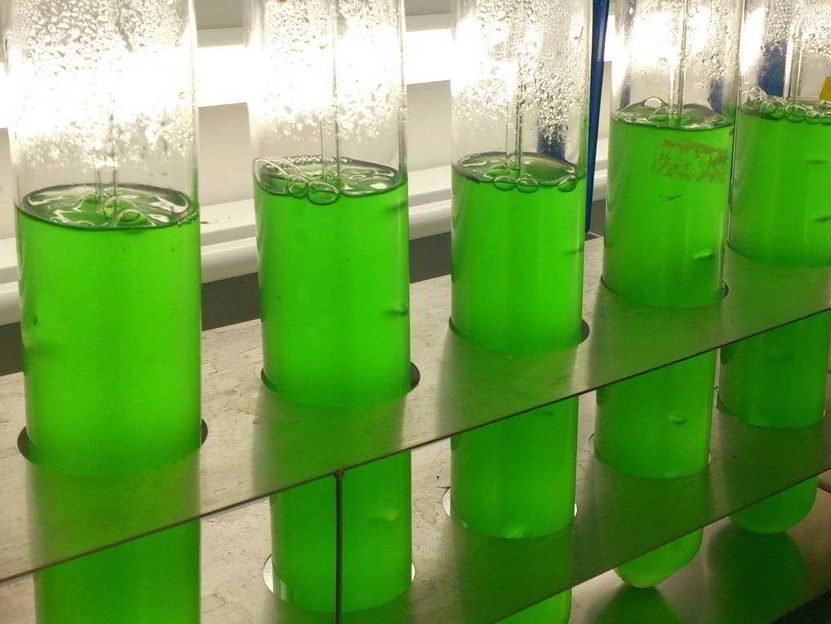Antibacterial Polymers
Surprising antibacterial activity and selectivity of hydrophilic phosphonium polymers
Artificial polymers, like antibiotic peptides, need both hydrophobic and hydrophilic domains in their molecular structure to exert antibacterial activity. Now, researchers from Canada have synthesized a phosphonium polymer that challenges this view. As outlined in the journal Angewandte Chemie, their polymer salt contained no hydrophobic alkyl chains but still acted as an extraordinarily efficient biocide. A re-evaluation of established strategies in antibiotics polymer research might be necessary.

© Wiley-VCH
To combat multiresistant bacteria and discover new antibiotics, scientists increasingly turn to the design and exploration of short artificial polymers. As these polymers can mimic the powerful peptide antibiotics, Paul J. Ragogna and Beth Gillies at Western University, London, ON (Canada), and their groups focus on phosphorus-containing polymers, the polyphosphoniums. Their molecular structure consists of a hydrocarbon backbone and a positively charged phosphorus center in every repeat unit. A balanced display of hydrophobic alkyl chains and positive charges was considered essential for effective adhesion to bacterial cells and membrane disruption. Envisaging still more effective cell lysis, the scientists started to fine-tune this amphiphilic nature of the polyphosphoniums.
Varying the relative content of hydrophobic and hydrophilic functional groups, the Western team introduced mannose sugars in the polymer. The sugar was intended to act as a “bait” to attract bacteria, according to the authors, but they found that this plan failed. “Our initial hypothesis that the mannose-containing phosphonium polymer ManPP would provide exceptional targeted activity proved incorrect,” they wrote. However, another functional group was extremely successful—and took the researchers by surprise.
They expected that the short alcoholic chain hydroxypropyl would not give any hydrophobicity to the polyphosphonium compound, thus producing neither bacterial cell lysis nor hemolysis of red blood cells. The degree to which a compound destroys red blood cells indicates the drug’s selectivity against mammalian cells. Thus, the hydroxy-modified polyphosphonium was intended for use as a control. However, it killed the bacteria with unprecedented activity while leaving red blood cells intact, the authors recorded. “This is an unprecedented result in the context of the literature on antimicrobial polyonium or related materials,” they wrote.
Their results signify that hydrophobic alkyl chains are no pivotal functional groups to attain cell lysis ability in phosphonium salt polymers. Instead, the authors hypothesize that the polystyrene backbone or the single terminal hydrophobic group of the synthesized polymers also play a role. These findings towards bactericide polymer structures deserve further investigation. A re-evaluation of the established models may be necessary. This is interesting news in the quest to design new antibacterial substances.
Original publication
Other news from the department science

Get the life science industry in your inbox
By submitting this form you agree that LUMITOS AG will send you the newsletter(s) selected above by email. Your data will not be passed on to third parties. Your data will be stored and processed in accordance with our data protection regulations. LUMITOS may contact you by email for the purpose of advertising or market and opinion surveys. You can revoke your consent at any time without giving reasons to LUMITOS AG, Ernst-Augustin-Str. 2, 12489 Berlin, Germany or by e-mail at revoke@lumitos.com with effect for the future. In addition, each email contains a link to unsubscribe from the corresponding newsletter.
Most read news
More news from our other portals
Last viewed contents

Moisture methods for pharmaceutical excipients - Collection of Moisture Analyzer Methods for Pharmaceutical Industry
Erich_Franz_Eugen_Bracht

Natural substance as alternative to controversial glyphosate? - Novel unusual sugar from cyanobacteria acts as natural herbicide
YM BioSciences granted Orphan Drug Designation for CYT387 - JAK1/2 inhibitor currently in Phase II clinical study in myelofibrosis

Novel test for the earlier detection of multiple cancers - Thrive Launches with $110 Million Series A Financing
Farber_disease
MRC Technology and Biocartis initiate development of liquid biopsy test for breast cancer
Devgen and Dogal receive regulatory approval in Turkey for the use of Devgen's nematicide product Devguard



















































